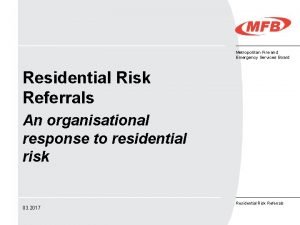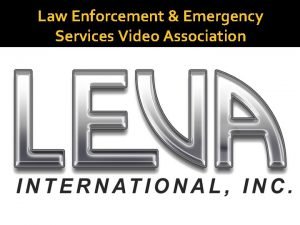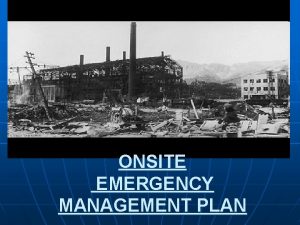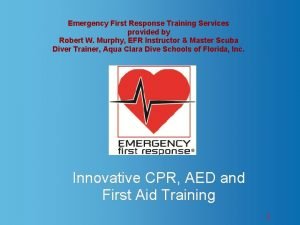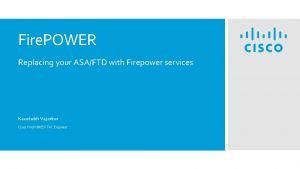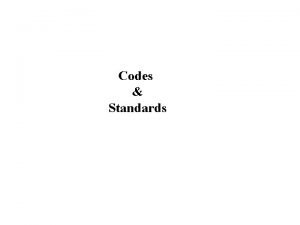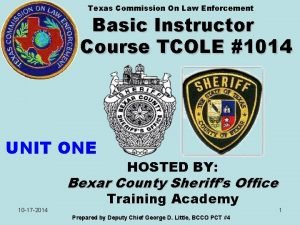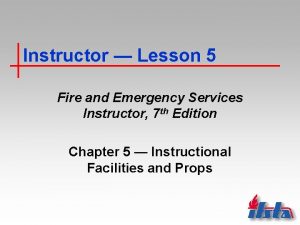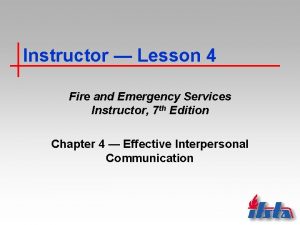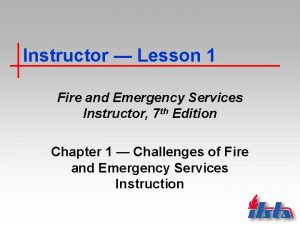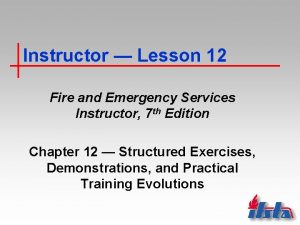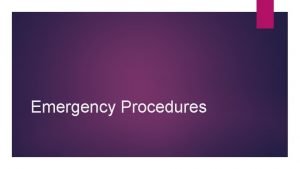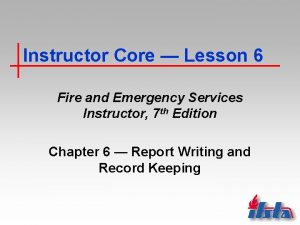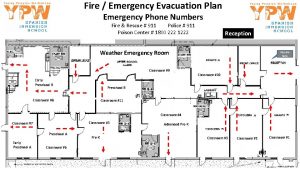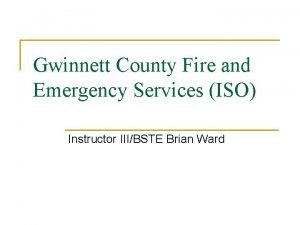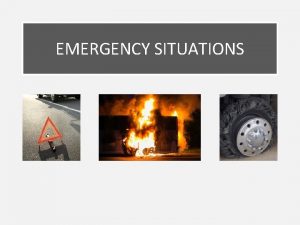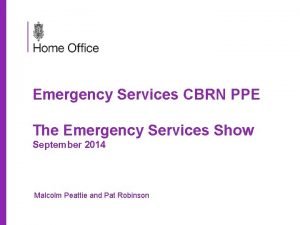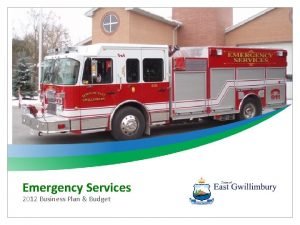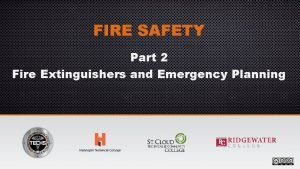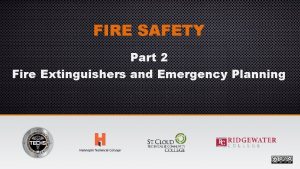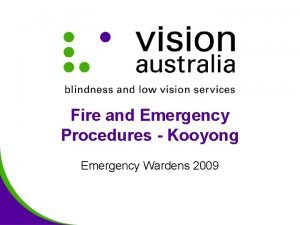Instructor Lesson 9 Fire and Emergency Services Instructor




















































- Slides: 52

Instructor — Lesson 9 Fire and Emergency Services Instructor, 7 th Edition Chapter 9 — Preparation for Instruction

Learning Objectives 1. Define a lesson plan. 2. Describe components of a lesson plan. 3. Distinguish among the steps in the four-step method of instruction. (Continued) Instructor 9– 1

Learning Objectives 4. Identify accurate statements about preparing to teach. 5. Discuss methods of ensuring course continuity. 6. Discuss methods of ensuring course consistency. (Continued) Instructor 9– 2

Learning Objectives 7. Identify types of classroom seating arrangements. 8. Identify accurate statements about controlling the indoor learning environment. (Continued) Instructor 9– 3

Learning Objectives 9. List considerations to address during the inspection and planning processes for outside instruction. 10. Analyze a prepared lesson plan. (Assignment Sheet 1) 11. Adapt a prepared lesson plan. (Assignment Sheet 2) (Continued) Instructor 9– 4

Learning Objectives 12. Respond to scenarios about adjusting presentations. (Assignment Sheet 3) 13. Arrange the physical setting of the learning environment. (Assignment Sheet 4) Instructor 9– 5

Lesson Plan • An instructional tool that establishes the steps that an instructor will take to complete the various objectives and ultimate goal of the course Instructor 9– 6

Components of a Lesson Plan • • • Job or topic Time frame Level of instruction Learning objectives Resources/materials needed (Continued) Instructor 9– 7

Components of a Lesson Plan • • • Prerequisites References Lesson summary Assignments Lesson outline Evaluations Instructor 9– 8

Preparation • Preparing students for learning • Motivate students • Establish lesson relevancy • ACID: attention, curiosity, interest, desire Courtesy Central Florida Fire Academy. Instructor 9– 9

Presentation • Presenting information in an orderly, sequential manner • Can be combined with application (Continued) Instructor 9– 10

Presentation • Outline should list: – Teaching methods – Learning activities – Demonstrations and practices – Support materials – Summaries Instructor 9– 11

Application • Provides opportunities for learning through activities and exercises • Reinforce student learning • Most learning takes place in this step • Can be combined with presentation Instructor 9– 12

Evaluation • Students demonstrate how much they have learned – Written/oral tests – Practical tests Courtesy of LSU. (Continued) Instructor 9– 13

Evaluation • Purpose is to determine whether students achieved the lesson objectives Instructor 9– 14

Attitude for Learning • Enthusiasm of the instructor affects students • Follow lesson plan • Primary responsibility of Level I Instructor is to teach from a prepared lesson plan Instructor 9– 15

Advance Organization • Being organized provides many benefits – Increased credibility – Improved efficiency – More effective use of resources – Reduced stress (Continued) Instructor 9– 16

Advance Organization • Begins with organization of work areas • Perform tasks related to a specific teaching topic • Organized presentation – Be familiar with the topic – Practice Instructor 9– 17

Session Preparation • An instructor who is not qualified to teach a topic should not teach it • Read and review necessary information and materials • Takes time to prepare Instructor 9– 18

Session Logistics • Instructor is usually responsible for acquiring logistical support • May consume class time • Make needed arrangements Instructor 9– 19

Course Continuity • Instructor changes – Know fellow instructors – Prepare the students – Meet with substitutes Courtesy Iowa Fire Service Training Bureau. (Continued) Instructor 9– 20

Course Continuity • Weather variations – Courses must be flexible – Do not expect students to learn in extreme conditions (Continued) Instructor 9– 21

Course Continuity • Equipment and material variations – Use the same type of equipment that is used in testing and on the job • Instructional resource variations – Make available to all instructors (Continued) Instructor 9– 22

Course Continuity • Testing location variations – Practice in the same place under similar conditions • Differences in learning styles – Use a variety of teaching methodologies – Be flexible and adapt if needed Instructor 9– 23

Course Consistency: Safety • Primary responsibility of instructors and students • Consistently adhere to safety policies and procedures • Be consistent in safety equipment and procedures Instructor 9– 24

Course Consistency: Training Materials • Should be identical to the types used in emergency activities • Consistency gives students knowledge of product or material • Need consistency in storing and accessing materials Instructor 9– 25

Course Consistency: Resource Materials • Instructors collect many resources for use in programs • Ensure that all sources can be cited and are acceptable Instructor 9– 26

Course Consistency: Approaches to Teaching • Consistency must exist between instructors teaching the course • Planning meetings can help in consistency Instructor 9– 27

Course Consistency: Skill Performances • Some jurisdictions have strict guidelines for performing skills • Consistency is even more important Instructor 9– 28

Seating Arrangments • Fan • Classroom • Auditorium or theater • Conference • Chevron • Horseshoe or U-shape • Hollow square • Round tables • Circled chairs (Continued) Instructor 9– 29

Seating Arrangements • Fan (Continued) Instructor 9– 30

Seating Arrangements • Classroom (Continued) Instructor 9– 31

Seating Arrangements • Auditorium or theater (Continued) Instructor 9– 32

Seating Arrangements • Conference (Continued) Instructor 9– 33

Seating Arrangements • Chevron (Continued) Instructor 9– 34

Seating Arrangements • Horseshoe or U-shape (Continued) Instructor 9– 35

Seating Arrangements • Circled chairs Instructor 9– 36

Indoor Learning Environment: Seating • Has an effect on how well students learn; comfort is important • Take breaks every 45 to 50 minutes • Ensure students can see and hear • Add additional tables if needed Instructor 9– 37

Indoor Learning Environment: Lighting • Should consist of both fluorescent and incandescent lights – Primary source should be fluorescent – Dimmer switches (Continued) Instructor 9– 38

Indoor Learning Environment: Lighting • Adjustable window blinds or roomdarkening shades or curtains • Inspect nonclassroom situations Instructor 9– 39

Indoor Learning Environment: Temperature • If too hot or cold will preoccupy students as they try to get comfortable • Instructor preparation may include operating HVAC thermostats Instructor 9– 40

Indoor Learning Environment: Noise Level • Students should not have to train in a high noise environment • High noise levels can be a safety factor • Eliminate or limit noise levels • If students are in-service or on call make arrangements before class Instructor 9– 41

Indoor Learning Environment: Audiovisual Equipment • • Arrange for use ahead of time Staff support may be necessary Preview audiovisual aids Give students a preview before presenting material Instructor 9– 42

Indoor Learning Environment: Other Considerations • • Power outlets Visual distractions Comfort facilities and emergency exits Safety hazards – Protect electrical cords – Eliminate tripping hazards Instructor 9– 43

Planning Outside Instruction • Visit and inspect the area • Provide an overview – Expected outcomes – Safety issues – Assignments – Walk through of area Instructor 9– 44

Outside Instruction Considerations • • • Weather conditions Terrain Vehicle traffic Vehicle and machine noise Light levels (Continued) Instructor 9– 45

Outside Instruction Considerations • • Site space Exposures Environmental laws and codes Access Instructor 9– 46

Summary • Instructor preparation is essential to a successful, effective, and efficient learning experience. Both instructors and students benefit from good preparation. (Continued) Instructor 9– 47

Summary • Instructors benefit by having increased self-confidence, while students have increased confidence in the ability and credibility of instructors. Instructor 9– 48

Discussion Questions 1. What is a lesson plan? 2. Describe three components of a lesson plan. 3. What are the four steps for developing a lesson plan? (Continued) Instructor 9– 49

Discussion Questions 4. Should an instructor who is not qualified teach a class? Why or why not? 5. How can an instructor ensure course continuity when there is a change of instructor? 6. Describe two types of classroom (Continued) seating arrangements. Instructor 9– 50

Discussion Questions 7. How should instructors prepare for audiovisual use in the classroom? 8. Name two items that an instructor must consider when planning outside instruction. Instructor 9– 51
 Metropolitan fire and emergency services board
Metropolitan fire and emergency services board Instructor responsibilities and professionalism lesson plan
Instructor responsibilities and professionalism lesson plan Law enforcement and emergency services video association
Law enforcement and emergency services video association Reichstag fire who was the fire starter
Reichstag fire who was the fire starter Fire damper connection to fire alarm
Fire damper connection to fire alarm Uttar pradesh fire prevention & fire safety rules, 2005
Uttar pradesh fire prevention & fire safety rules, 2005 Ire fire fire rwi
Ire fire fire rwi Fight fire with fire definition
Fight fire with fire definition National emergency services academy
National emergency services academy Onsite emergency services
Onsite emergency services Emergency response training services
Emergency response training services Firepower fire services
Firepower fire services Virtual instructor.com
Virtual instructor.com Code standards and practices 1 lesson 2
Code standards and practices 1 lesson 2 Tipología de los participantes
Tipología de los participantes Tcole instructor course
Tcole instructor course Basic instructor course texas
Basic instructor course texas Basic instructor course #1014
Basic instructor course #1014 Pepperball instructor course
Pepperball instructor course Neither of my two suitcases is adequate for this trip
Neither of my two suitcases is adequate for this trip Instructor vs teacher
Instructor vs teacher Ospfv
Ospfv Mptc firearms instructor manual
Mptc firearms instructor manual Basic instructor course #1014
Basic instructor course #1014 Basic instructor course #1014
Basic instructor course #1014 Nfpa 1403
Nfpa 1403 Human factors instructor
Human factors instructor Instructor operating station
Instructor operating station Catia instructor
Catia instructor Instructor
Instructor Tcole 1014 basic instructor course
Tcole 1014 basic instructor course Usmc jrotc vacancies
Usmc jrotc vacancies Nrp instructor toolkit
Nrp instructor toolkit Utp cable
Utp cable What is cbrf training
What is cbrf training Nra certified instructor logo
Nra certified instructor logo Naismith was an instructor of
Naismith was an instructor of Please clean the room before you live
Please clean the room before you live Tcole advanced instructor course
Tcole advanced instructor course Tcole advanced instructor course
Tcole advanced instructor course Jrotc marksmanship instructor course online
Jrotc marksmanship instructor course online Ames room illusion
Ames room illusion Cyan medical terminology
Cyan medical terminology Basic instructor course #1014
Basic instructor course #1014 Basic instructor course #1014
Basic instructor course #1014 Delmar cengage learning instructor resources
Delmar cengage learning instructor resources Instructor office hours
Instructor office hours Intserv vs diffserv
Intserv vs diffserv Wake county human services community services center
Wake county human services community services center Example of micro teaching lesson plan
Example of micro teaching lesson plan Sat vocabulary lesson 4
Sat vocabulary lesson 4 The science duo physical and chemical changes
The science duo physical and chemical changes Lesson 4 gravity and motion lesson review
Lesson 4 gravity and motion lesson review
